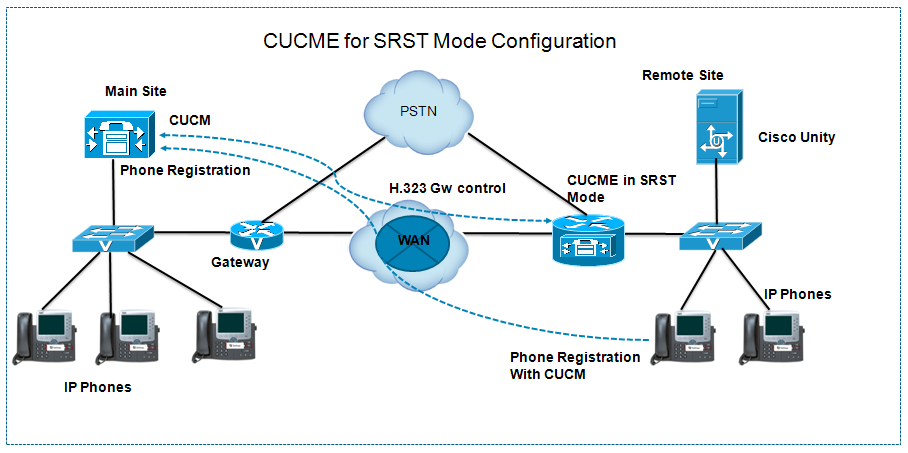- Cisco Community
- Technology and Support
- Collaboration
- Collaboration Knowledge Base
- How to implement CUCME in SRST Mode?
- Subscribe to RSS Feed
- Mark as New
- Mark as Read
- Bookmark
- Subscribe
- Printer Friendly Page
- Report Inappropriate Content
- Subscribe to RSS Feed
- Mark as New
- Mark as Read
- Bookmark
- Subscribe
- Printer Friendly Page
- Report Inappropriate Content
04-29-2012 07:09 AM - edited 03-12-2019 09:45 AM
Introduction
This document covers the configuration procedures for implementing Cisco Unified Communications Manager Express (CUCME) in Survivable Remote Site Telephony (SRST) mode.
CUCME in SRST Mode
SRST is an IOS feature that enables routers to provide call-handling support for Cisco IP Phones if they lose their connection to a remote Primary CUCM which can occur if the WAN connection to the main site is down.
When CUCME provides Cisco Unified SRST functionality, provisioning of phones is automatic. Most CUCME features are available to the phones during periods of fallback, including hunt groups, Call park, and access to Cisco Unity voice messaging services using SCCP. The benefit is that CUCM users gain access to more features during fallback without any additional licensing costs.
Advantages of CUCME SRST
Using CUCME in SRST mode has several advantages compared to using standard SRST:
- CUCME provides more telephony features than standard SRST.
- CUCME in SRST mode allows a mix of preconfigured phones and directory numbers for phones and DNs that require individual settings and phones that are not configured but are learned by SNAP.
- The additional features of CUCME can be leveraged by pre-configuring the required individual settings in CUCME to benefit SRST.
- ephone configuration is based on MAC addresses, ephone-dn configuration is based on directory number.
- All phones and DNs that collectively require identical configuration not provided by SNAP do not have to be preconfigured, but the additional configuration can be applied using templates.
- These features allow flexible configuration of any CUCME feature in a scalable way because only those devices have to be preconfigured, which requires individual settings.
Phone Registration Process
When a phone loses connectivity to its CUCM, it registers to its configured SRST reference. If that SRST reference is CUCME in SRST mode, the CUCME router first searches for an existing preconfigured ephone with the MAC address of the registration phone. If an ephone is found the stored ephone configuration is used. No phone configuration settings provided by SNAP are applied, and no ephone template is applied.
If the ephone is configured with one or more ephone-dns, the stored configuration is used for the phone's ephone-dn or ephone-dns. If no ephone is found for the MAC address of the registration phone, CUCME adds the ephone and applies the ephone template if it is configured using SNAP. If the directory number exists, it is bound to the added phone; otherwise, the directory number is learned using SNAP. If it is configured, the ephone-dn template is applied.
Figure shows a topology that can use SRST fallback support using CUCME.

CUCME Basic Configuration
CUCME Basic Configuration
The following example shows Cisco Unified CME Basic Configuration
telephony-service max-ephones 5 max-dn 10 ip source-address 10.1.101.102 port 2000 create cnf-files
! ephone-dn 6 number 3001 ephone-dn 7 number 3002
! ephone 3 mac-address 0012.0154.5D98 type 7960 button 1:6
ephone 4 mac-address 0007.0E57.6F43 type 7961 button 1:7
! dialplan-pattern 3 5215553... extension-length 4 ! ! |
Configuring CUCME for SRST
Configuring CUCME for SRST:
To enable SRST mode for CUCME, use the srst mode auto-provision command in telephony-service configuration mode,
CMERouter# configure terminal
CMERouter(config)# telephony - service
CMERouter(config- telephony)# srst mode auto-provision {all / dn / none}
CMERouter(config- telephony)# srst dn line-mode {dual / single}
Configuring ephone-dn template for SRST mode:
To specify an ephone-dn template to be used in SRST mode on a CUCME router, use the srsn dn template command in telephony-service configuration mode,
CMERouter# configure terminal
CMERouter(config)# telephony - service
CMERouter(config- telephony)# srst dn template template-tag
CMERouter(config- telephony)# srst ephone template template-tag
CMERouter(config- telephony)# srst ephone description string
CUCME for SRST mode configuration
The following example shows CUCME configuration in SRST mode
CMERouter# configure terminal
CMERouter(config)# telephony-service
CMERouter(config- telephony)# srst mode auto-provision none
CMERouter(config- telephony)# srst dn line-mode dual
CMERouter(config- telephony)# srst ephone template 1
CMERouter(config- telephony)# srst dn template 3
CMERouter(config- telephony)# srst ephone description
CMERouter(config- telephony)# max-ephone 10
CMERouter(config- telephony)# max-dn 30
CMERouter(config- telephony)# ip source-address 10.1.101.102 port 2000
CMERouter(config- telephony)# exit
CMERouter(config)# ephone-template 1
CMERouter(config-ephone-template)# keep-conference local-only
CMERouter(config)# ephone-dn-template 3
CMERouter(config-ephone-template)# hold-alert 25 idle
In this example, CUCME uses ephone-template 1 for newly added phones. This template configures conference to drop if no internal members are left in the conference. ephone-dns, which are learned using SNAP, are configured to alert the users if a call is on hold for 25 seconds and the phone is idle. The description of learned phones should be CUCME SRST, and the ephone-dns should be dual-mode lines. |
Related Information
- Mark as Read
- Mark as New
- Bookmark
- Permalink
- Report Inappropriate Content
Excellent work ...well documented.
Find answers to your questions by entering keywords or phrases in the Search bar above. New here? Use these resources to familiarize yourself with the community: